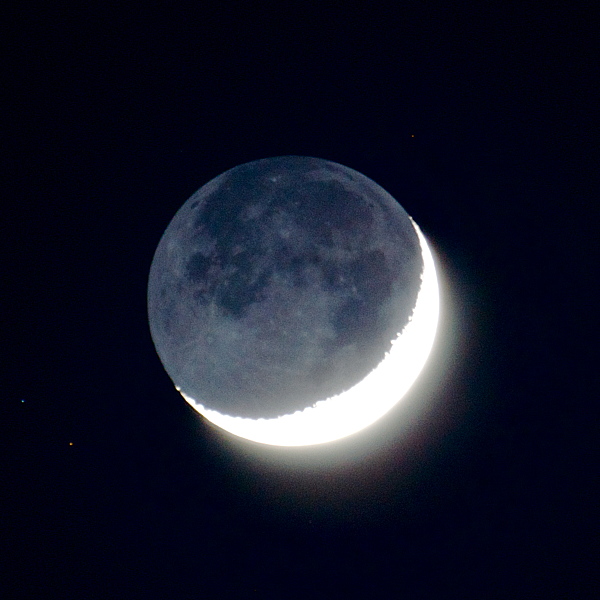
Comet C/2013 R1 (Lovejoy), Crescent Moon,
Crescent Venus, and IC348 Nebula
Posted: 6 December 2013
Cloudy skies resumed after the last session. Even had some rain overnight Wednesday-Thursday, 4-5 December 2013. Got 0.4" of rain, with a light dusting of snow before sunrise (the first of the season). During the afternoon on Thursday, went to the observatory and wiped rain water off the dome in anticipation of being able to open up after sunset.
From 1800 MST to 1840 MST, I attempted to observe and image Comet C/2013 R1 (Lovejoy) from my front patio. The temperature was 34°F. While waiting for the western sky to darken, I took some photographs of the crescent moon and Venus:
f/4.5, 1/5sec, 110mm, ISO 400

f/5.6, 1/160sec, 300mm, ISO 400 (cropped)

f/5.6, 1 sec, 300mm, ISO 400 (cropped)

I thought I saw Comet Lovejoy in 7x50 binoculars. I did some imaging of that location and checked them during post-processing with SkySafari Pro on my Macintosh. In fact, I did see and image the comet. This image was taken at 1834 MST, f/4.5, 10 seconds, 70mm, ISO 1600:

(Rollover or tap the image to see a label)
I opened the observatory at 1850 MST, 39°F. At 1858 MST, viewed Venus, 83X. It showed a nice crescent phase, but was getting into a tree. I then viewed the moon, nearly at the same crescent phase as Venus, 83X. I did some afocal imaging of the moon, 83X, using the iPhone 5s (handheld). This image captured the Earthshine:

And this is the crescent moon, done with the iPhone 5s (handheld), 83X:

I switched to the 2" 9mm eyepiece + 2" 2X PowerMate (for 444X) and took a quick look at Venus. Although Venus was low in the sky, the view was still pretty good. I did some iPhone 5s afocal video recordings at 444X. Venus would overexpose since I had no filters on the eyepiece (I don't have any 2" filters), but this is roughly how it appeared (one frame from a slo-mo video):

At 1916 MST, I did some lunar observing at 444X. Since the moon was low the seeing was not very good, but there were some nice sights at times. I removed the PowerMate and did some brief lunar observing, 222X. While I was observing the moon, my iPod Classic, which was playing music from the Carl Sagan "Cosmos" TV series, shutdown due to the low temperature (36°F).
Next, I attached the D7000 DSLR at prime focus of the 8" LX200-ACF using an off-axis guider. I did a focus test on the star Algol using a Bahtinov Mask. I slewed the telescope to IC348 (diffuse nebula) and did a 1 minute, ISO 6400, framing test image. The nebula was nicely centered but I could not locate any guide star. So I did 5 unguided 1 minute, ISO 6400, exposures. This is a stack of the six 1 minute exposures (cropped), done in Lynkeos:

At 1959 MST, I noticed that a cloud was in the constellations of Perseus (where IC348 is located) and Auriga. I waited a few minutes to see if the cloud would move out of the way. It didn't; in fact, the cloud cover increased. I decided to end the session.
The observatory was closed at 2016 MST, 33°F. The sky was mostly overcast as I left the observatory.
Comments are welcome using Email. Thanks.
Cassiopeia Observatory Home Page